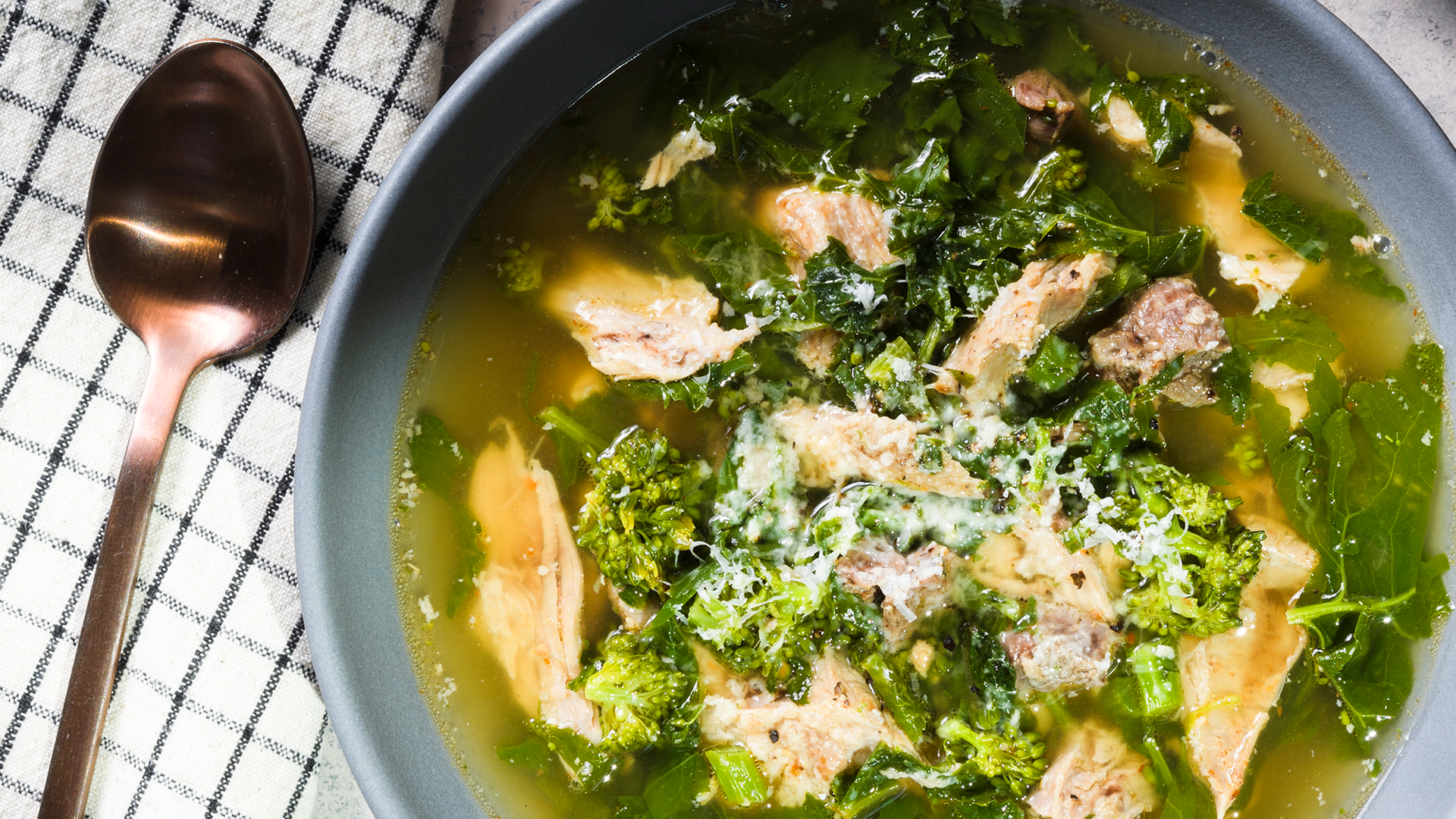
Let’s get it out of the way now: This soup is nothing like what you find in glass jars on supermarket shelves. If you clicked this article hoping for a noodle and meatball-filled dupe, you won’t find one. And that’s a good thing; our Italian Wedding Soup from “Milk Street 365” is so much better.
Minestra maritata, directly translated from Italian as “married soup,” or “wedding soup” is a staple throughout Italy, but the name is slightly deceiving. Despite what comes to mind, you would be hard-pressed to find it served at any weddings outside of Campania, where it is considered the celebratory dish for marital unions. Instead, “married” in this context refers to the melding or “marriage” of meats and greens cooked low and slow until they’ve unified into a symphony of flavors ranging from fresh and herbaceous to rich and savory. Quick and weeknight friendly this multi-step, multi-hour soup is not, but if you’ve got an afternoon free, you’re promised a generous reward.
We first tried minestra maritata in Naples, where editorial director J.M. Hirsch was taught two equally delicious, but very different versions. The first was a weeknight-simplified two-pot wonder in which a broth was built by boiling a chicken with celery, tomatoes and garlic. In another pot, a medley of greens and Pecorino. Just before serving, the broth was strained and poured over the pot of greens and cheese and set on a slow slimmer until tender. The chicken was added back into the pot right at the end.
The second soup, a more traditional version, was made using pork and beef and inexpensive, easily accessible greens like escarole, broccoli leaves and savoy cabbage. Much like its chicken counterpart, the meat and greens are prepared separately before being married together in the pot and served, but with double the protein, the cooking process takes considerably longer.
Back in the States, our recipe developers set out to create a soup marriage of their own, working to streamline the process while maximizing flavor. The result is what my husband described as “nostalgic,” a full-bodied soup stuffed with spicy pancetta, tender cuts of bone-in beef and pork, a classic mirepoix of onions, celery and carrots (removed along with the pancetta before serving) and broccoli rabe, which adds vegetal freshness and satisfying crunch thanks to a quick blanch in the broth. With so many meats and greens, you’d think that this hearty, cold weather-friendly soup would be too heavy, but it’s quite the opposite—it’s light and comforting, yet warming enough to enjoy even on the most blisteringly-cold nights.
Flavorful veggies start with the right fat
You start by rendering the pancetta in olive oil until it’s slightly crispy and golden brown. Then you add your mirepoix (carrots, celery, onion), cooking until your onions are translucent and everything is soft and tender. (Many recipes hinge on uniform cuts of your vegetables, but in this recipe, no need to be so precise! Your mirepoix is there for a good time, not a long one.)
For an extra oomph of umami, we brown the tomato paste, which tamps down the acidity and brings out notes of sweetness. Garlic and a generous amount of red pepper flakes are also added at this stage for subtle heat and savoriness.
Bone-in meat makes a better broth
Many of our soup recipes call for the use of store-bought broth, but in this recipe, water’s all you need. The reason for this is that you’ll be cooking your bone-in pork ribs and beef shank on a 2-hour simmer. Not only does this make the meat tender enough to fall off the bone, it allows the bones to release their collagen, resulting in a fortified broth that’s rich in body and taste. And don’t forget to toss a parmesan rind in as well for an added boost of savory-cheesy flavor.
Remove the Solids
This may be a vegetable-rich soup, but that doesn’t mean you should keep all of your veggies in the pot. With such a long simmer, your mirepoix, along with the pancetta, have released every ounce of flavor extractable and no longer serve a purpose. Fishing out your solids before adding the meat back in ensures a silky-smooth broth that really lets your proteins shine.
Skim your stock!
Slow-simmered meat is supreme, but it does come with a challenge: unwanted fat. Once your meat is nice and tender and removed from the pot to become cool enough to hand-shred, make sure that you skim off as much fat that has floated to the top as you can. It might be difficult to see at first, but by carefully tilting the pan to one side and holding it under the light, you’ll be better able to tell what’s broth and what’s not. Heed my warning: This is perhaps the most crucial step of all. if you don’t properly remove as many of the impurities as you can, you’ll end up with a solid layer of congealed fat in your refrigerated container; quite the annoyance when it comes time to reheat leftovers, of which there will be plenty.
Join the conversation on Facebook, Instagram, TikTok and Pinterest.
And if you’re looking for more Milk Street, check out our livestream cooking classes with our favorite chefs, home cooks and friends for global recipes, cooking methods and more.


